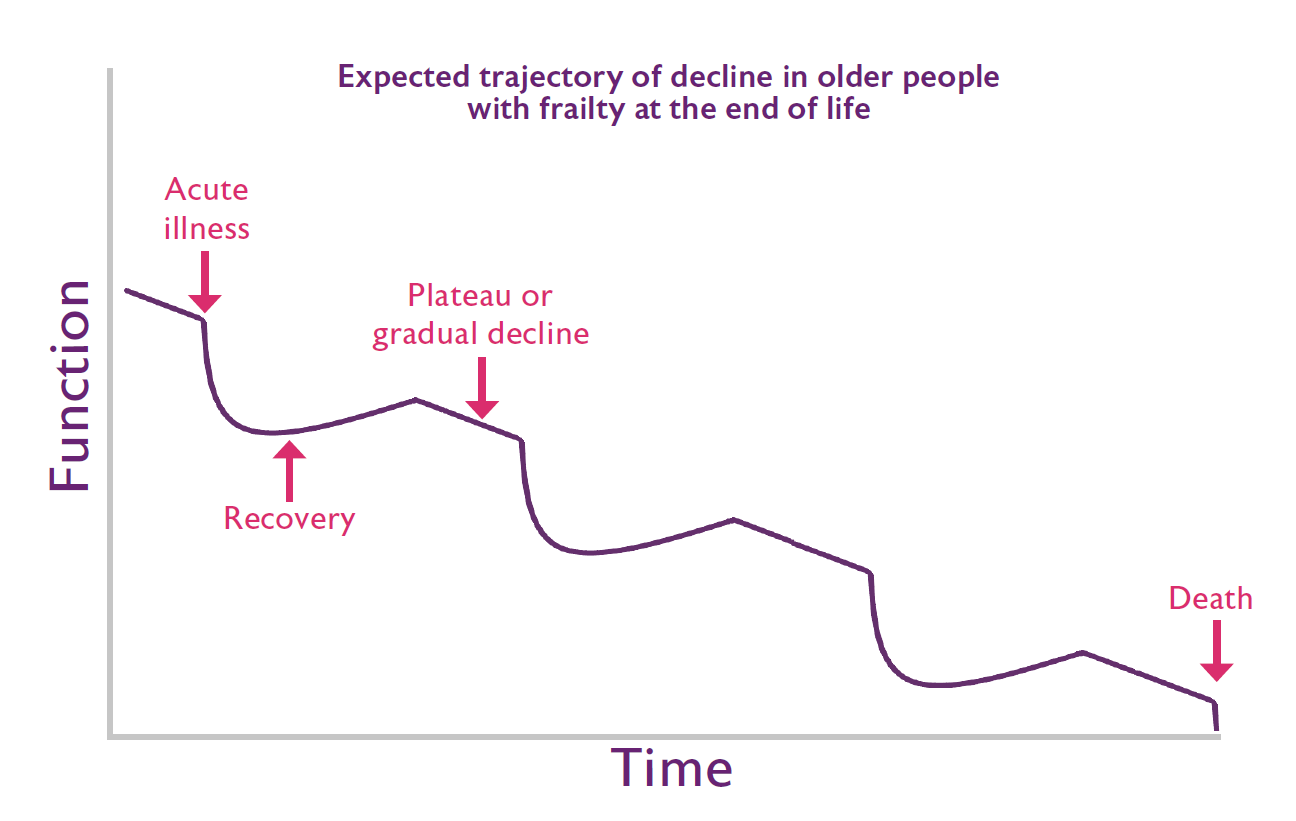End of Life Care in Frailty: Identification and prognostication
Why is identification of end of life important in frailty?
Although frailty is a leading cause of death in older people, it is often not recognised nor considered at end of life. Late recognition can impede both choice of place of care and patient-centred decisions. Both lead to inappropriate life-saving interventions and to under-treatment of palliative symptoms and concerns. Indeed, transitions into hospital in the last year of life, and hospital deaths, are common for older people living with frailty. The cost is borne by older people themselves, their family and the NHS. Proximity to death, rather than age, is the strongest driver of health care expenditure - and yet end of life experiences, for both older people with frailty and their families, are often poor.1
What does identification of end of life mean?
Identifying that someone is moving towards end of life is necessarily based on individual need, rather than a clear prognosis. This is particularly the case for older people with frailty. The functional trajectory of frailty describes a progressive decline or prolonged dwindling over several months or years, punctuated by episodes of acute illness. This unpredictable trajectory makes it difficult to know for certain when people are nearing the end of life.2 Healthcare professionals may be reluctant to identify a person with frailty as approaching end of life when there is no clear underlying pathology.3 This means that using ‘time until death’ as the sole indicator of end of life need is unhelpful.
For example, the ‘surprise’ question, “Would I be surprised if this patient died in the next 12 months?” has been shown to have poor to moderate performance in specificity and sensitivity in identifying older people with frailty in the last year of life.4 People with severe frailty are five times more likely to die in a year than older people without frailty.5 Therefore the identification of older people living with frailty, through clinical assessment, using validated tools or the use of population risk profiling (e.g. the Electronic Frailty Index5), followed by clinical assessment to determine the degree frailty, is of paramount importance.
Severe frailty is an end-of-life state and should trigger a healthcare professional to identify and sensitively discuss end of life needs and preferences. The Comprehensive Geriatric Assessment (CGA) can be a useful tool to identify needs and to direct a focused care plan.
There are several tools to help identify people nearing end of life, often combining disease-specific assessment criteria and clinical indicators of decline. Some are specific to care settings (see Resources).
Identification is often through situational diagnosis combining clinical indicators indicating end of life need6 including:
- Two or more unplanned hospital admissions in the past 6-12 months
- Persistent and recurrent infections
- Weight loss of 5-10% in the past 6 months
- Multiple morbidity in addition to frailty
- Combined frailty and dementia
- Delirium
- Exacerbation of falling
- Rapidly rising frailty score
- Escalating patient, family or service provider distress
- Older person asking for palliative care support and/or withdrawal of active treatment
What is clear is that older people with frailty will have end of life needs that are often progressive in nature.7 However, because the presentation of these needs can be sudden as well as incremental and unpredictable, the evident risk of deterioration should, across all care settings, be a trigger for end of life care planning (see Figure). Identification and planning end-of-life care when recovery is not certain is a fundamental aspect of care for all older people with frailty, and should be clearly communicated, where appropriate, to the older person and their family.
Clinical uncertainty accepts and manages the inherent uncertainties of living and dying well with frailty. The focus moves from identifying dying to a focus on parallel planning– where there are several possible outcomes across specialties, some becoming more obvious over time and some less likely. Both recovery and dying are therefore possible outcomes, and clinical teams and specialities work together with the person and their family with that understanding in mind. This integration of geriatric medicine and palliative care enables clinicians to share together active decision-making about when to start and change treatment, clinical care and symptom control. In addition, it provides opportunity for sensitive discussions about current and future expectations with older people and their family, to support each other. Thinking ahead requires engagement, with small and incremental changes in a person’s condition over time. Tools can help family and social carers to map these changes as a basis for the appropriate response.
Discussing clinical uncertainty
Within the wider MDT
Importantly, embracing clinical uncertainty changes the emphasis from “getting the time of dying right,” to working together to support older people with frailty “to complete their lives well in the last phase of life.”8 As a multidisciplinary team, it is important to understand the unpredictable nature of decline in frailty. There is opportunity to engage proactively together, in shared decision-making and ongoing support, with regard for the risks and benefits of various clinical options.
With older people and their family
Professionals can find it hard to discuss clinical uncertainty with older people and families. Evidence suggests that frequently patients and family want uncertainty to be made explicit, understanding that while death was a possible or probable outcome, it was not certain. For example, in a retrospective study of deaths in acute settings, family members wanted clear information about possible outcomes in understandable terms, .e.g. “X is sick enough to die.” Trisha Cantley’s analogy of a person with severe frailty as a paper boat can be helpful in communicating uncertainty (see Resources).
Information sensitively given can reduce distress. However, each patient’s and families’ priorities will be different, requiring an individually tailored approach. Etkind et al9 noted three responses to clinical uncertainty in life limiting illness:
a) Patients who were disengaged, did not want information and focused on the present;
b) Patients who were fully engaged, wanted full information and considered the present and future; and
c) Patients who expressed intermediate views on level of engagement with their condition, amount of information they wanted or whether the focus is on present or future events.
The identification and communication of entering the end of life for older people with frailty requires attention to the realities of living and dying over time. Identification of end of life is important; it allows for an optimal clinical response and gives the older person and their family a sense of security and control despite a changing condition. It enables older people with frailty both to live and to conclude their lives well.
References
- Hazra NC, Rudisill C, Gulliford MC. Determinants of health care costs in the senior elderly: age, comorbidity, impairment, or proximity to death? The European Journal of Health Economics. 2018;19(6):831-42.
- Gill TM, Gahbauer EA, Han L, Allore HG. Trajectories of disability in the last year of life. New England Journal of Medicine. 2010;362(13):1173-80.
- Elliott M, Nicholson C. A qualitative study exploring use of the surprise question in the care of older people: perceptions of general practitioners and challenges for practice. BMJ supportive & palliative care. 2017;7(1):32-8.
- Downar J, Goldman R, Pinto R, Englesakis M, Adhikari NK. The “surprise question” for predicting death in seriously ill patients: a systematic review and meta-analysis. Canadian Medical Association Journal. 2017;189(13):E484-E93.
- Clegg A, Bates C, Young J, Ryan R, Nichols L, Ann Teale E, et al. Development and validation of an electronic frailty index using routine primary care electronic health record data. Age and ageing. 2016;45(3):353-60.
- Nicholson C, Davies JM, George R, Smith B, Pace V, Harris L, et al. What are the main palliative care symptoms and concerns of older people with multimorbidity?—a comparative cross-sectional study using routinely collected Phase of Illness, Australia-modified Karnofsky Performance Status and Integrated Palliative Care Outcome Scale data. Annals of palliative medicine. 2018;7:S164-S75.
- Stow D, Spiers G, Matthews FE, Hanratty B. What is the evidence that people with frailty have needs for palliative care at the end of life? A systematic review and narrative synthesis. Palliative medicine. 2019;33(4):399-414.
- Krawczyk M, Gallagher R. Communicating prognostic uncertainty in potential end-of-life contexts: experiences of family members. BMC palliative care. 2016;15(1):59.
- Etkind SN, Koffman J. Approaches to managing uncertainty in people with life-limiting conditions: role of communication and palliative care. Postgrad Med J. 2016;92.
Resources
- Amber Care Bundle
For use in hospitals when clinicians are uncertain if a patient may recover - Gold Standard Framework - Proactive Identification Guidance
A framework to enable early identification of patients at end of life across care settings. - NECPAL CCOMS-ICO© Tool Version 1
Tool to identify Advanced- Terminal patients in need of palliative care -within health and social services - Supportive & Palliative Care indicators Tool 9 SPICT™
The SPICT™ helps identify people with deteriorating health due to one or multiple advanced conditions. - BGS Blog: The Paper Boat - Trisha Cantley
Communicating clinical uncertainty for people with frailty


